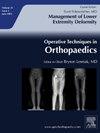Operative Techniques in Orthopedics: Ulnar Nerve Transfers
IF 0.3
Q4 ORTHOPEDICS
引用次数: 0
Abstract
Ulnar nerve injuries, whether traumatic or iatrogenic, lead to profound motor and sensory impairments, including reduced grip strength, fine motor dysfunction, and deformities like claw hand. The ulnar nerve, originating predominantly from the C8-T1 roots, traverses anatomically significant regions like the cubital tunnel and Guyon's canal, where it innervates muscles critical for hand function and provides sensory input to the ulnar hand and fingers. Functional recovery is constrained by the slow axonal regeneration rate (1 mm/day) and delayed presentation, necessitating alternative treatments such as nerve and tendon transfers. Diagnostic evaluation, including electrodiagnostic testing, imaging, along with clinical assessment is essential for treatment planning. Commonly performed transfers include the anterior interosseous nerve (AIN)-to-ulnar nerve transfers for proximal injuries and the opponens pollicis to deep ulnar motor branch for distal injuries. The development of novel nerve transfer and improved surgical techniques have demonstrated promising success for improving motor reinnervation and sensory restoration. These techniques have transformed the prognosis for ulnar nerve injuries, offering functional recovery and improved quality of life.
矫形外科手术技术:尺神经转移
尺神经损伤,无论是外伤性的还是医源性的,都会导致严重的运动和感觉障碍,包括握力下降、精细运动功能障碍和爪状手等畸形。尺神经主要发源于C8-T1根,穿过肘管和盖恩管等解剖学上重要的区域,在那里它支配对手部功能至关重要的肌肉,并向尺骨手和手指提供感觉输入。功能恢复受到轴突再生速度慢(1毫米/天)和延迟表现的限制,需要替代治疗,如神经和肌腱转移。诊断评估,包括电诊断测试,成像,以及临床评估是必不可少的治疗计划。常用的转移包括对近端损伤的骨间神经(AIN)到尺神经的转移和对远端损伤的掌侧神经到尺深运动分支的转移。新型神经移植技术的发展和手术技术的改进在改善运动神经再生和感觉恢复方面取得了很大的成功。这些技术已经改变了尺神经损伤的预后,提供功能恢复和提高生活质量。
本文章由计算机程序翻译,如有差异,请以英文原文为准。
求助全文
约1分钟内获得全文
求助全文
来源期刊

Operative Techniques in Orthopaedics
ORTHOPEDICS-
CiteScore
0.40
自引率
0.00%
发文量
40
审稿时长
83 days
期刊介绍:
Operative Techniques in Orthopaedics is an innovative, richly illustrated resource that keeps practitioners informed of significant advances in all areas of surgical management. Each issue of this atlas-style journal explores a single topic, often offering alternate approaches to the same procedure. Its current, definitive information keeps readers in the forefront of their specialty.
 求助内容:
求助内容: 应助结果提醒方式:
应助结果提醒方式:


